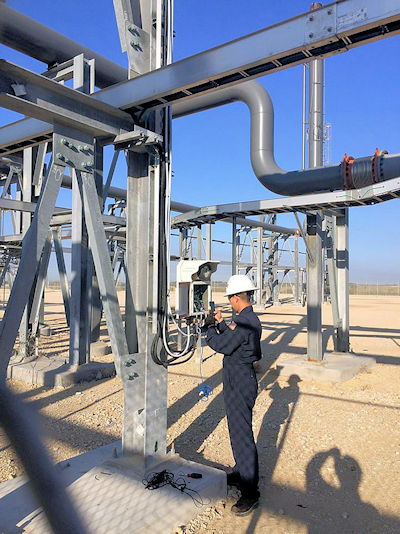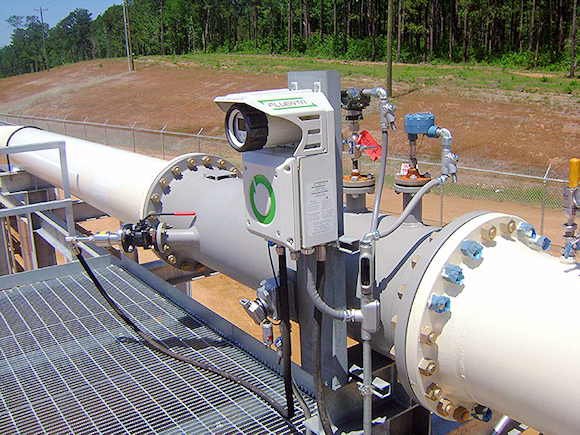
The Internet of Things (IoT) is changing the capability of businesses to measure and manage a range of previously standalone infrastructure. In flare-gas operations, businesses are deploying this capability to monitor flaring volumes remotely and seeing transformative results in terms of cost reduction, emissions management, and new revenue streams. While deploying this capability in gas-flaring operations will be crucial for the energy sector in the coming decades, any business that measures gas can adopt the same principles to increase efficiencies and generate new revenue streams.

The practice of gas flaring poses several concerns such as environmental and operational costs.
Cloudy Conditions
Cloud technology has already made a significant impact on business operations for companies measuring gas. Whereas historically computing power was limited to on-site equipment, businesses now have access to almost unlimited computing power through the cloud.
While adoption within flaring operations is still in its infancy, the technology is poised to change gas management fundamentally. Remote gas measurement through cloud platforms can vastly reduce cost and, more significantly, risk. Operations in hostile and hazardous locations are more efficiently manageable and organizations can better manage risk. For the energy sector, this can also support the necessary management of greenhouse gas emissions.
Data Streams Are A Sea Of Potential
Gas measurement infrastructure can be difficult to access. In hostile environments, such as oil rigs, it is often hazardous for engineers tasked with operating and maintaining equipment. In both scenarios, remote access to measurement data can reduce cost. Historically it has been necessary for personnel to check whether assets are working on-site. This costs time and money and, for the oil and gas industry, means inserting a human being into a dangerous environment.
Cloud technology enables businesses to remotely monitor gas measurement assets and access real-time data feeds. The best platforms allow data to be accessed from multiple devices, anywhere in the world. Data is received instantly, insight gained quickly, and action can be taken as soon as possible. Wherever gas measurement occurs, access to improved information in real time enables more informed strategic decision making.
Next page
Emissions Reductions Are A Necessary Step
Remote data streams for diagnostics using telemetry are already used in sectors such as utilities. Data feeds are used to manage tasks such as asset well-being reporting, or for more sophisticated diagnostics, such as software updates.
With remote asset monitoring through the internet using cloud technology, applying this process to gas measurement in other industries has the potential of a transformative effect. In the oil and gas industry, the ability to monitor flare gas volumes in real-time will support the necessary transition to carbon emissions reduction. A 2015 International Energy Agency (IEA) report, 'CO2 Emissions from Fuel Combustion Highlights' estimates that more than 40% of global CO2 emissions come from the power sector, with a further 20% resulting from large-scale industrial processes such as chemicals production.

Live rig monitoring vs. IoT remote monitoring via the Cloud.
The ability to feed real-time CO2 emissions data into a continuous emission monitoring system (CEMS) in the cloud will allow organizations to collect, record, and report data remotely. Insight gained from data analytics in turn enables more effective management of emissions across multiple sites, even if they are in different countries.
Next page
Strategic Implementation
With initiatives like COP21 and the World Bank's Zero Flaring by 2030 drive, it is likely that new legislation on the measurement and monitoring of gas volumes will soon be introduced. This will make it mandatory for companies to practically manage legally binding, large-scale reductions.
Companies should therefore be investing now to meet this trend head on, supporting a better return on investment when large-scale reductions are necessary. Putting the technology in place now will enable companies to work towards ensuring new developments incorporate gas utilization solutions in a cost-effective way.

IoT solution for gas flaring.
Several countries are already demonstrating that this is possible. In Kazakhstan, a joint venture of Chevron, ExxonMobil, Kazmunaigaz, and LukArco has eliminated gas-flaring emissions in the giant Tengiz oil field by 94%. Azerbaijan has cut flaring by 50% in two years, Mexico by 66% and Kuwait now only flares 1% of its gas. Other countries, including Qatar and the Democratic Republic of the Congo, now use large volumes of previously wasted gas to generate electricity.
Many companies currently flare excess gas for reasons of simplicity. Working out cost-effective ways of implementing cloud technology now will mean significant reductions in emissions are a realistic possibility when they become mandatory. Real-time data feeds can also be used to create a competitive advantage. Data retrieved from different sites can be compared to manage the flaring process more effectively, by site to site, country to country, or process to process, thereby enabling continuous improvement over time. Best practice can be taken from top-performing, low-emission sites and implemented across an entire operation.
Conclusion
Successful implementation is the result of detailed planning, as well as careful execution. Impending regulatory changes mean businesses should be planning now to ensure a successful implementation when the time comes. With cloud technology data is stored off-site, and while this can overcome many of the problems associated with traditional hardware upgrades, careful planning is still important.
With increasing pressure to optimize business strategy, the visibility offered by connected gas measurement technology can help companies streamline efficiencies across operations of any size. For companies that flare gas, it can also support the move towards large-scale capture and storage solutions, and ultimately reductions in carbon emissions.
About the Author
Lana Ginns is the Marketing Manager at Fluenta, specialist in ultrasonic flow measurement for the oil-gas-gas and chemicals industries. Her extensive technical and marketing experience, which covers both B2B and B2C, ranges from complex engineering equipment to essential oils.